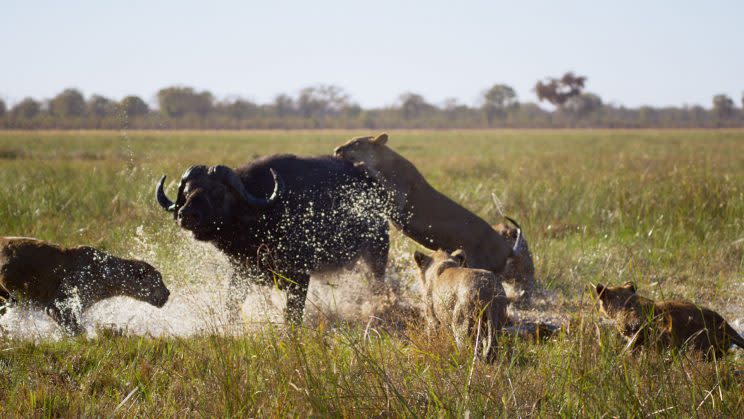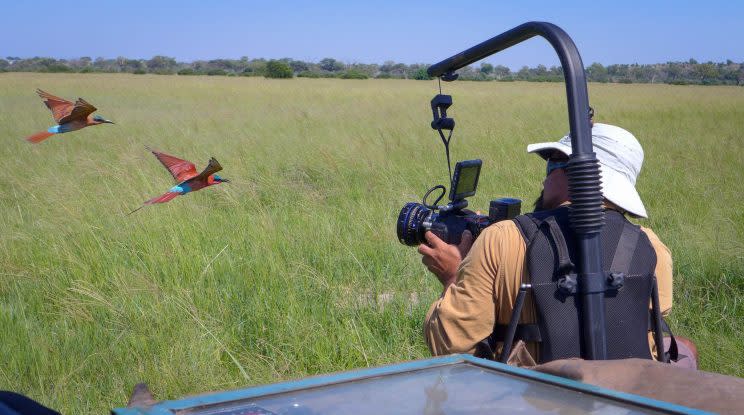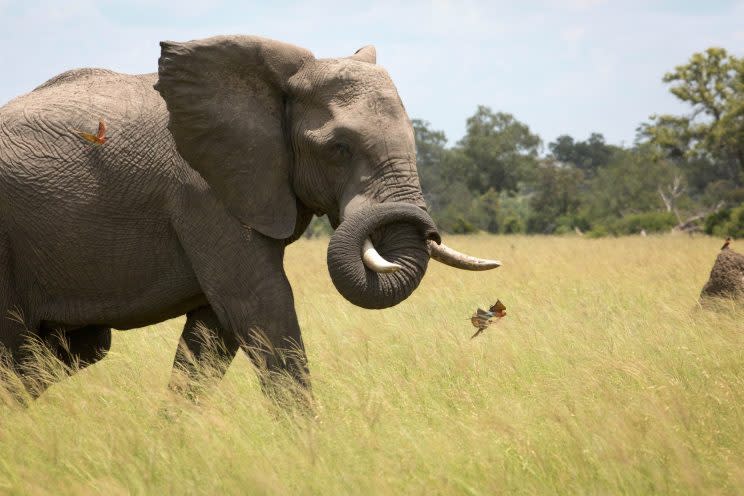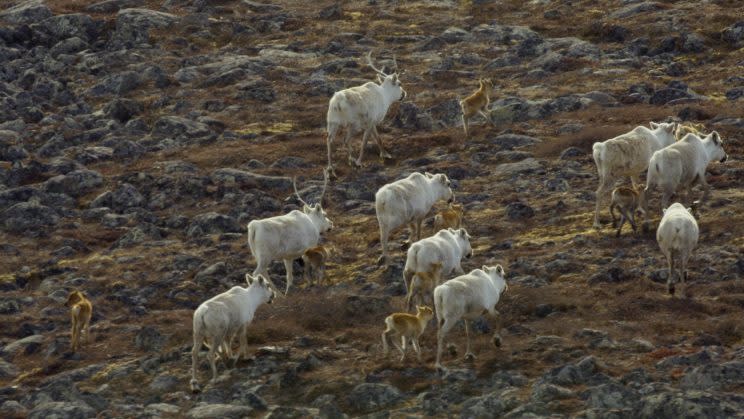‘Planet Earth II’ Preview: Love and (Near) Death in the Grasslands
Planet Earth II continues Saturday night on BBC America with the “Grasslands” episode. As you can see from the exclusive sneak peek above, in which an agile harvest mouse goes full-on Mission: Impossible — with her prehensile tail in an English meadow, swaying on grass stems to snatch food and evade a barn owl — there will be moments of levity in the hour.

There will also, however, be some truly dramatic survival stories — not just for the animals, but also for “Grasslands” producer/director Chadden Hunter and his crew behind the scenes. Here, Hunter — who spent three and a half years working on the episode — offers Yahoo TV a preview of five more sequences and the stories about how they were captured.

Swamp Cats
A pride of lions known as “Swamp Cats” have learned to hunt in the flooded swamps of the Okavango Delta, Botswana. The water adds an extra challenge because the lionesses — who need to make a kill so their 3-month old cubs won’t starve — can’t get the traction needed to be able to pull down a buffalo. As long as the buffalo — which weighs more than the five lionesses combined and uses its horns as a weapon — remains standing, the odds are it will walk away, albeit bloodied, provided its stamina outlasts that of the pride. The battle of wills (4 heart-pounding minutes in the episode) is one of series executive producer Mike Gunton’s favorite sequences because it shows the intense struggle of both animals in such a visceral way. “The water flying everywhere — it’s sort of Tarantino-esque,” he says. “It’s almost operatic, balletic, which makes it feel kind of Godfather-esque.”
The sequence proved the most difficult for Hunter, starting with the fact that it took him two seasons in the field to witness the behavior. “One of our bosses once said, ‘If we’re not coming back with some failures, we’re not trying hard enough,'” he says. “That was a really fantastic piece of management because it encouraged us to get out there and really go after some stories that might be really difficult to get. In this day and age, with the Internet and with cable television and people having so much access to content, it’s really much tougher for us to blow people away with something new.”
Hunter ventured hundreds of miles into the Okavango Delta on a tiny boat with local cameraman Brad Bestelink. On one trip, the water level was lower than they’d expected and their boat began getting stuck in the vegetation. “We had angry hippos in front of us and angry hippos behind us, and the cameraman started casually saying, ‘Oh, don’t go near the hippos. They broke my last boat in half with one bite. They can just snap the boat in half,'” Hunter says.
“So we were trying to dodge the hippos,” he continues, “and then we had to jump out into the water and push the boat ourselves. We were in armpit-deep black water, pushing this boat above our heads across the top of the vegetation. Then the cameraman said, ‘Oh, we need to take off our shoes now.’ I was like, ‘What are you talking about?’ He said, ‘Well, for the crocodiles.’ He said if you press down on a crocodile’s back with your shoes on, you won’t know what it is — you’ll just press down, and the crocodile will spin around and take your leg off instantly. But with bare feet, you can feel the back of a crocodile’s skin. It’s unmistakable. So we were going through this swamp for hours and hours where every single footstep you put down feeling for crocodiles, thinking, ‘God, is that crocodile skin? Is that a crocodile’s back?’ In terms of just the sheer physical challenge of getting into location, that one was pretty brutal.”
Hunter turned the camera on them for some of that trek, which became the BBC “Earth Unplugged” video above. At the end of this particular day, as he and Bestelink were returning to camp, a hippo stood in the channel between them and home. So as not to not startle and anger it, they waited for it to move on — for more than an hour. They also, as the video shows, cracked open a beer. “Yeah, you’re not supposed to see that,” Hunter says with a laugh. “Those are the scenes that we don’t often let the viewers see. That was Survival 101 right there. It’s kind of a ‘What else can you do now?’ type thing.”

Kaziranga National Park
The Making of Planet Earth II — which airs March 25 — takes viewers behind the scenes of Hunter’s time in the tall Indian elephant grass in the world’s most dangerous national park. “Basically, it’s an impenetrable world of this thick green grass. The elephants push through, and they create these paths, and then other animals follow them over the years — rhinos, tigers, and buffalo. So you get this amazing labyrinth of green tunnels, which very very few humans go into because it’s so dangerous. More people are killed in Kaziranga than in any other national park in the world,” Hunter says.
His crew went in with a guard armed with an old rifle that could fire a warning shot if needed. “On foot, when you’re that close to the animal, you can’t see them. You’ve got angry elephants not far from you. You’ve got grumpy rhinoceros. They’re just uncertain of what is in the grass as well. Trying to keep everybody safe is my responsibility as a producer/director. That gave me gray hairs in that long grass in India,” he says.

What became clear to Hunter was that setting up remote cameras in the grass was the safer way to go. One small problem: “The animals started dismantling those one by one, in quite cunning ways,” he says. “I don’t think it was just sheer vandalism; it was actually quite calculated. These animals really wanted to keep their secrets.”

Ultimately, a local Indian cameraman, Sandesh Kadur — who’d become obsessed with getting the shots they wanted — took matters into his own hands. “He knew places where he could camouflage fully in grass and sit there for days on end,” Hunter says. “The animals may not be able to see him now, but he said he was sitting there in that little grass hut and he could hear the rhinos breathing behind him. And then these two male rhinos started getting into a fight and were chasing each other around in the grass right behind him. He just thought, ‘Oh, one footstep and I’m killed here.’ But we got him out alive in the end.”
Jackson’s Widowbirds Jumping Contest
This sequence will tickle anyone who enjoyed the Wilson’s bird-of-paradise in the “Jungles” episode of Planet Earth II. As you see in the sneak peek above, male widowbirds in Kenya compete for female attention by seeing who can jump the highest above the grass for the longest amount of time. “That was Sir David Attenborough’s favorite sequence in the ‘Grasslands’ film,” Hunter says. “That was another story that took us a while to get because the widowbirds only really do their courtship dancing when the conditions are absolutely spot-on — when the grasses are nice and high, full of seeds and food. The first season we tried that in Kenya, the rains had failed and we saw one sad male try to jump once, but he was quite limp. Then, the second season, we had good rains, then all the males started going for it. But it was trying to find a patch where you had multiple males dancing near each other and competing, which was tough.”
After they found a group of suitors, filming them was easy. “The nice thing about those widowbirds is they were a species that lets you get quite close to them. Once those males get obsessed with showing off for the females, they’re pretty bulletproof, and so it allowed us to change camera angles, it allowed us to really build the story of the males and the females and the competitors,” Hunter says. “What I love about that is really, really building a character out of our animals. I think that’s something that people look for in these big series — that kind of emotional connection. I love a story that takes a loser and turns it into a hero. Sometimes our bosses will say, ‘Oh God, not another bird story. You know, birds aren’t that sexy.’ But when you can milk that character, and those widowbirds are just so delightful, they really do make you smile. To see a male struggling — we can all sympathize with trying to find a mate or a date. I think it really was a heartwarming sequence, so I always look out for those stories in a film.”

Carmine Bee-eaters’ Free Ride
Hunter got a tip from locals that when they drove in the tall grass, bee-eater birds would follow the Jeeps because the wheels kicked up insects. Hunter knew his team could use new stabilization technology to get into intimate shots of the birds hunting, as seen in the photo above. But he also knew they could capture elephants serving as the waiters.

Hunter admits this story was a hard sell with his bosses. “What I loved about it was how connected to grass it was. I was always trying to look for those stories that really told us something about how the animal has to survive in grass and what kind of ingenious solution it has,” he says. “The bee-eaters can’t get to their food at all without a bigger animal to stir it up. So I thought this is a wonderful opportunity to draw multiple species into one story, which is a very Disney-esque way to do storytelling. It’s rare that we get that chance, but I knew that we’d get some nice character out of them.”
The story got even more crowded, to his delight. “We were going for the elephants and the bee-eaters, and we knew that if we saw a big bull walk through, then the bee-eaters might follow, but we’d have to keep our distance. What we didn’t realize is that the ostriches and the kori bustards were coming through, and the bee-eaters were opportunistically following along with those guys and riding on the backs. That was one of those treats where we were just given this little extra layer to the story, which added another smile to your face. Seeing a bird riding on the back of another bird cheekily like that is just one of those wonderful little moments that I think lifts the film.”

Caribou Migration
Every hour of Planet Earth II needs a story of spectacle, and this one is a special one. More than 70,000 caribou calves will be born in the span of a few days in Canada’s Barrenlands. When they are just days old, their mothers gather them to begin the longest overland migration in the animal kingdom. The aerial shots are so beautiful, you may tear up. “There’s a nobility about them,” Gunton says. “It reminds you of the power of nature and the extraordinary things that are going on every day on the planet that we have absolutely no idea about.”
For Hunter, sequences like this and the similar tale of Saiga antelope calving herds in Kazakhstan at the start of the hour are a nod to the original Planet Earth. “I think what really blew people away with Planet Earth was just that it felt so grand and stately and really showed you those vast landscapes. Of course, with Planet Earth II, we were trying to go more intimate, we were trying to get more immersive, but I didn’t want to lose sight of the fact that people love those epic landscapes,” he says. “Caribou have the ultimate grassland story: From the day those little calves are born, they’re up against it. They’ve got to be on their feet and moving, literally on Day One. And then for the rest of their life, it’s forever trying to deal with the changing nature of grasslands themselves.”
The caribou migration is the final sequence in the episode, because Hunter wanted to make people rethink their view of grasslands. “They’re not just this flat, benign habitat where animals go to kill each other; they’re actually a really dynamic landscape that can throw up incredible challenges,” he says. “So I wanted for that to feel like a big, rousing end that really celebrated grasslands.”
Hunter himself had reason to celebrate while in the field for this sequence — he survived an encounter with a grizzly bear. One day, he went out walking alone on the tundra (prepared with bear spray, etc.) in search of the arctic wolves that prey on the caribou and spotted a big male grizzly in the distance. “I could see him smelling. I could see that he could tell where I was. I must have had some trail mix in the bag. He started coming straight toward me. I’m watching this through binoculars at first. ‘Oh God, okay, here he comes.’ I knew I wasn’t supposed to run. My camp manager said, ‘Don’t run. Only prey runs.’ So I started walking back toward the camp as fast as I could, and I held my video camera up over my shoulder, like a rearview mirror,” he says. “I was watching on the little side screen on the video camera, so that I could watch the bear behind me get closer and closer, knowing that I couldn’t run. If I ran, then that was it — the bear would catch up. Simultaneously, I could give a little message to my loved ones — to my family and fiancée — saying, ‘Look, if I don’t get out of here, this has been a fantastic experience.’ I did make it back to camp, but that was a pretty hair-raising moment.”
Planet Earth II airs Saturdays at 9 p.m. on BBC America.
Read more from Yahoo TV’s Planet Earth II coverage:
‘Planet Earth II’ Preview: Giraffe vs. Lioness in the Desert
‘Planet Earth II’ Heads to the ‘Jungles’: Producers Preview 7 Moments
‘Planet Earth II’ Producers Preview Must-Watch ‘Mountains’ Moments
‘Planet Earth II’ Executive Producer Mike Gunton Previews Top ‘Islands’ Moments


